 CULTURE CULTURE |
The people of Madagascar are a mixture of Indonesian and African. There are people with Asiatic characteristics who have light complexions and sleek hair, as well as typical African features. 18 tribes, comprising a total of about 15 000 000 inhabitants, make up the population of Madagascar.
The largest of them are:
• The ANTANDROY, semi-nomads, chose to gather in the south as long as the 16th century. Their physical appearance is like that of the Africans.
• The BETSILEO, robust, hard-working and excellent rice growers, live in the east center.
• The MERINA are of Malay origin. The have inherited their Asiatic' ancestors characters. They live in the high plateaus of the center and in particular in the capital, Antananarivo.
• ...And so many other human groups, as different from one another, whether facially or traditional-wise.

Family of Betsileo farmers
The Malagasy language has many dialects but these 18 tribes have one thing in common with some slight variation, is spoken and understood everywhere in the island.
AUSTRONESIAN is now the preferred term for the Malayo-Polynesian language family. Its eastern group (300 languages, over 1 million speakers) is so different from the western as to have barely traceable links. It includes the Polynesian, Micronesian and Melanesian (but not Papuan) branches. The western group's 200 languages (over 170 million speakers) are closely related (but not mutually intelligible). Javanese has the most speakers. Others include Sundanese (also in Java); Malay (Bahasa Indonesia and Bahasa Malaysia); Batak,Minangkabau and Achinese in Sumatra; Balinese and many languages of eastern Indonesia; Tagalog (Filipino), Cebuano, Ilocano, Ilongo and Bicolano in the Philippines; Cham (spoken by a minority people in Vietnam and Cambodia); and eighteen dialects in the African island of Madagascar.
Most contemporary and traditional Malagasy music revolves around dance rhythms with influences from Indonesia and the African mainland, notably Kenya. These rhythms are accompanied by the flute, whistle and valiha, a unique, 28-stringed instrument resembling a bassoon but played more like a harp. The lokanga voatavo, or cordophone, is also popular, as are a few types of guitar, including the kabosy, similar to a ukelele. Vaky soava is a rhythmic style of singing accompanied only by hand clapping, and perhaps the most renowned exponent is Paul Bert Rahasimanana, who developed a personal style that included adding a musical accompaniment. He weaves themes of poverty, love, loss and hope into his music.
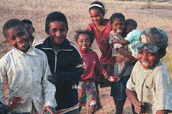
The regional town of Fianarantsoa has developed into a literary capital of sorts in recent years, and several contemporary novelists and writers work there. While literature didn't really flower until the 1930s and 40s, traditional oratory, called kabary, is highly regarded. Kabary's roots are in early political assemblies, in which each speaker spoke in turn. It evolved and was eventually popularised and extended to the general public as a form of entertainment. Kabary is an integral part of hira gasy, popular spectacles that include music, dancing and story telling, held regularly in Tana on most Sunday afternoons.
While Madagascar officially shares one culture and language, the Malagasy people are divided into 18 tribes whose boundaries are based on old kingdoms rather than ethnic characteristics. Most Malagasy are of mixed race, but some, such as the Merina from the Antananarivo area, are predominantly Indonesian in appearance, and others, like the Vezo of the south-west coast, have close ties to eastern Africa and look like black Africans. As a matter of fact, any business men interested in doing business in Madagascar need to know that a Merina doesn't accept to receive orders from a Sakhalav (or Vezo) and vice versa. It is still true nowdays.
Despite the status of French as the official language, Malagasy is widely spoken. It belongs to the Austronesian language family, which includes Indonesian and many Polynesian languages, and its closest linguistic cousin is spoken on southern Borneo. It has also adopted words from French, Arabic, nearby African languages and English.
Around 50% of Malagasy follow traditional religions, and even confirmed Christians (41%) usually still devoutly carry out traditional practices. The Malagasy regard the dead with awe and reverence, and give the afterlife as much importance as the present; the dead play a role in the life of the living rarely seen in other cultures. Mourners carry out elaborate rituals at funerals, and if it is deemed that the dead are displeased, further rituals are enacted to appease them. The most famous of these is the famadihana, or turning of the bones, when the dead are exhumed, entertained, talked to and reburied with gifts and new shrouds. There are several Muslim communities, and Muslims comprise about 7% of the population.
The dominant element of any Malagasy meal is vary or rice, and vary doesn't accompany the meal, the meal accompanies the vary. Roadside canteens normally offer a big plate of rice with a few tidbits to garnish it, such as beef, fish or poultry. Other than rice, favourite Malagasy dishes include romazava (beef and vegetable stew) and ravitoto (pork stew with manioc greens). Many dishes are accompanied by achards, a hot, pickled vegetable curry. The seafood on the coast is excellent and cheap, and you can eat a range of tropical fruits (voankazo) such as pineapples, lychees, mangoes and bananas for most of the year.
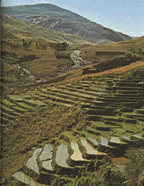
The French influence ensures that the coffee is drinkable and more popular than tea. The local THB or Three Horses Beer is also good. Around Ambalavao and Fianarantsoa they produce several wines, including a greyish-coloured one appropriately enough called gris. The rotguts come in several different kinds but all are strong enough to unblock your pipes. Toaka grasy is a crude rum made from rice and sugar cane; trembo is a coconut toddy; and litchel is an alcoholic fruit drink made from lychees. Up the scale is a distilled rum called roma.
 FAITHS FAITHS |
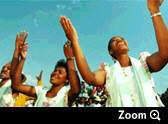
A kaleidoscope of 15 million people, with African, Arab and Eastern blood. Madagascar is a preserved miracle of nature, a drift in the Indian Ocean, a fascinating and unspoilt mosaic of landscapes and populations. However, with the diversity of the races and the ways of life, the Malagasy conception of the universe and the place of the man in this universe is similar in all the island and is a factor of deep unity. All the Malagasy people have in common the search of integration and fusion within the family clan, in the territorial community, with God, the ancestors, nature and cosmos.
 Traditional faith Traditional faith |
Malagasy people are animist. They believe traditionally in only one God " ZANAHARY ", creator of the universe, the nature and the men. Only 45% of the population is Christian. However, there is no border between the 2 beliefs, since the Christians, Catholic or Protestant, continue to practise the traditional rites. In fact, most practise a kind of syncretism with a more or less harmonious combination of monotheism and an ancestor worship.
 The world of sacred The world of sacred |
All Malagasy respect the immemorial taboos or " fady " and keep the "vintana", a religious calendar which defines the occupations for each day of the week. Rites, traditions, daily rules are governed by many fady, preserved in proverbs. In general, man does not communicate directly with Zanahary. For that, there are the ancestors " Razana " who are charged to take care on the alives and who are the intermediaries between God and the alives
 The cult of the dead The cult of the dead |
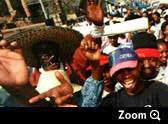
Malagasy never speak about dead but of the ancestors " razana " because death does not exist. No end, no rupture, death is a passage to another life. The individual passes from a physical state to a higher state where he becomes a spirit " fanahy ", near to God. During this transformation, he acquires wisdom and the knowledge which enables him to guide their relatives and to stand by them. But if the razana can bless, they can also punish someone who does not respect the traditional rules. The behavior of the individuals is governed by a complex system of uses " fomba " and taboos " fady ".
The no following of these rules involves dishonour and deserves a punishment, often in the form of a malediction given by the razana. Thus, tradition and also ancestors, who have an immense power, must be respected. This power is the spirit, the " fanahy " which means here judgement, knowledge and supernatural capacity. The razana are consulted or evoked at every moment. And to make sure of the protection of razana and to have their benediction, it is necessary to give them a worthy tomb and to take care regularly of their bodies. For that, there are several funeral and burial rites. |  Tomb Tomb |
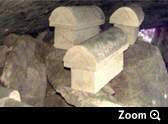
The dead are omnipresent in the everyday life, the family tombs border the dwelling houses. The family tomb is on the ground of the ancestors " tanindrazana ", crowned ground which will never be sold because it represents the true fatherland. Each one has as objective to be buried on the ground of its ancestors. The tomb constitutes the central point which links all the members of a family, all the generations. The tombs are built always better than the houses. The dead having to be there for eternity, their residences must last in time. For this reason the tombs are built in stone. So the construction of a tomb is very expensive. The size and the decoration of the tombs reveal the wealth and the prestige of a family. Tombs are built according to the vintana system. Many taboos " fady " must be considered. For example, tomb are never built at the north of a village, because it is the place of joy; the building of tomb is prohibited when the rice is shooting because rice shoots mean birth contrary to the building of tomb.
 Famadihana Famadihana |
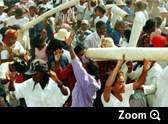
The " turning of the dead " (exhumation of the corpses of the dead) is a duty crowned towards the ancestors and gives the opportunity to the family to make cleaning inside tombs and especially to replace the ancestors shrouds. At a particular date, indicated by an astrologer, the family tomb is opened and the dead is exhumed. The ceremony is never sad because each one must feel a complete satisfaction of the accomplished duty towards the ancestors. This day is a feast-day with good meal, dancing, music and songs. The tradition requires that the family offer up a zebu cattle as a sacrifice and share out its flesh among all the present guests. The costs of the celebration are enormous. The dead are exhumated very early in the morning and are laid side by side in the grass during the day. They attend thus the feast. Each one can touch them, speak to them. At the end of the day, they are wrapped in new silk shrouds " lambamena ", hoisted onto the shoulders of their relatives and carried in procession seven times around the tomb before being replaced on their beds of stone. An other kind of " famadihana " occurs when the family tomb is full. The new tomb should not receive diretly recent dead because they are impure. Thus the tomb must be inaugurated by a " famadihana " where an ancestor from the old one is transferred and placed on on the bottom shelf. For reasons of hygiene, the famadihana are always done during the dry season, in winter
 VINTANA VINTANA |
Astrology takes an important place in the life of Malagasy people. They believe in "vintana" ie destiny which is under the influence of "asters" and particularly of moon. Destiny fixes the personality, the daily life and the future of every one. Destiny was instituted by Andriamanitra (God) and is written since the birth. Only Andriamanitra can change it. Each day, each month has its vintana. So, there are lucky days and unlucky days as there is good destiny and bad destiny according the day and the time of our birth.
Traditional house serves as a model of the vintana system. The house represent the year and it is divided in 12 corresponding to the 12 months. The house is always oriented on the north-south axis which is correlated to the world of the living. The east-west axis evokes the relation between the living and the dead. The north-east side of the house is considered as warm, good and superior. It is the side of sunrise where ancestors came from. The dead are placed here before funeral. Into the house it is the side reserved to the bed of the chief of family. Each man has his place in this side according his age. The west side is associated to woman. Traditional house have one room; in the center there is the central pillar (andry), symbol of father who is the pillar of the home. Near the andry, there is the fire-place for cooking, symbol of union of the family.
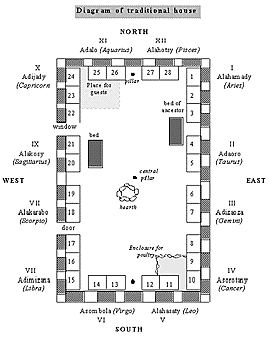
The year has 28 destinies but each month have also 28 destinies corresponding in fact to the lunar cycle. Here are the name of the 12 months: 1. Alahamady, 2. Adaoro, 3. Adizaoza, 4. Asorotany, 5. Alahasaty, 6.Asombola, 7. Adimizana, 8. Alakarabo, 9. Alakaosy, 10. Adijady, 11. Adalo, 12. Alohotsy. Four of these months have 3 destinies each one (the mouth "vava", the middle "vontona" and the end "vody"): Alahamady, Asorotany, Adimizana, Adijady. These are called the vintana mothers (renim-bintana). They are located at the four corners of the house. The others months have 2 destinies each one. Alahamady is the first lunar month of the year, located at the north-eastern corner. It is the monthe of the king and the nobles. Alohotsy is the last. All the 28 destinies come back 12 times a year.
Destinies facing each other in the house diagram can be opposed. A man and a woman with opposing destinies cannot get married. If a child come into the world with a destiny opposed to those his father, his mother or one of his brother and sister, the misfortune must be send away by a sacrifice or an incantation. An incision is made in the left ear of the new-born child and in the left ear of the one who has the opposite destiny. The blood is mixed and smeard on the both of them. If a child come into the world a day with the same destiny that an other member of the family, a common destiny, the same ceremony must be made. But a child having a common destiny with his father must leave home and be entrust to an other person. Like opposing destinies, common destinies have an important influence on the life of Malagasy people
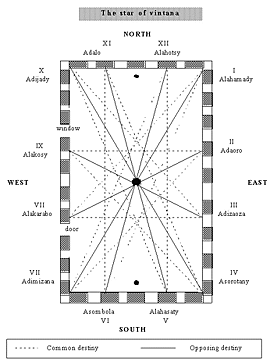
Each day have also its own destiny. Good destinies become unfavorable if they fall on unlucky days. Each day have 28 destinies and its own color with symbolic meaning. The first destiny, at the sunrise, is named "mouth of Alahamady" like those of month destiny. The seven days have different meanings with regard to destiny and they influence the interpretation of the 28 destinies.
Destiny of each day:
Sunday (Alahady) is the white day. Seniors consider it as the first day of the week, the day of sacrifices and adoration. Sunday is very powerful and may be dangerous. It is taboo to bury a corpse on a Sunday. If it is absolutely necessary to do it, it must be done after sunset when the sun is "dead".
Monday (Alatsinainy) is the black day: many tears, many sorrows. This day is suitable for funerals. It is no advisable to start any important work on a Monday because it will take an hard effort to complete the work afterwards.
Tuesday (Talata) is a light day: the day for insouciance and hapiness. It is very risky to make an alliance with somebody on this day. This day is good for making sacrifices and for corpse exhumation.
Wednesday (Alarobia) is a brown day. Seniors say that it is the eldest of all days. It is an evil day and therefore it is a good day for sacrifice. It is not a day for travelling. It is also the woman day.
Thursday (Alakamisy) is a black and laborious day, the day for slavery. It is wise to start the building of a new house on Thursday.
Friday (Zoma) is the red day. This color symbolizes the power of king and authorities and also the death and bloodshed. This day have a strong destiny.
Saturday (Asabotsy) is the day for children.
It is not easy to determine the number of good days and unfavorable days in a year. In fact, It is not enough to count the 28 monthly destinies coming back 12 times a year. It is necessary to consider also the destiny of days, of seasons and phases of moon. Every one is not able to read the asters, only a mpanandro (diviner) can do that. Before to undertake an important event (wedding, circumcision,...), Malagasy people are used to see him.
From the vintana of days and of months, many taboos (fady) and superstition have been defined. For example, it is forbidden to open tombs during the "mouth of Adimizana" because that could increase the number of dead. Thereby, it is better that famadihana are done during Alakarobo or the "middle of Asorotany" because those destinies are the symbol of union and soldering. So, the tomb door will be sealed and will never open to receive new dead before a member of the family become old. These periods are favorable to undertake things that ones asks guarantee of quality, duration, fidelity and continuity. These 2 destinies are suitable to inaugurate a house, celebrate a marriage or do famadihana (exhumation of dead). The Adizaoza destiny is favorable for seed-time particularly of rice; plants will dig in strongly and will bear vigorous leaves |

